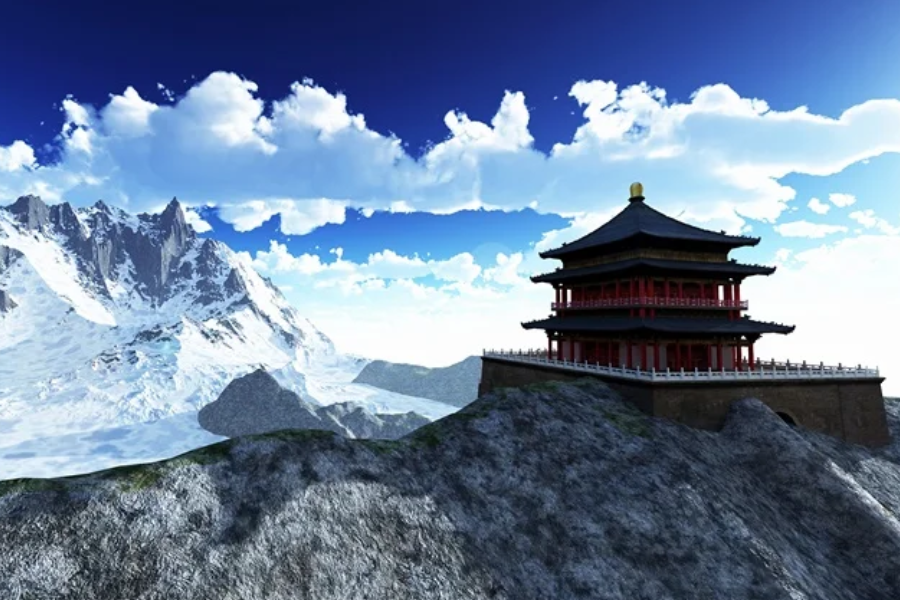The Himalayas, famously known as the “abode of snow,” span across five nations: Bhutan, China, India, Nepal, and Pakistan. This awe-inspiring mountain range is more than just a collection of towering peaks; it is a diverse and intricate landscape that has drawn explorers, pilgrims, and adventurers for centuries. Central to this imposing range is the notion of the Himalayan resting place, both a metaphorical and physical refuge that provides tranquility, seclusion, and a deep connection to nature and spirituality. This article examines the allure and significance of these resting places, highlighting their cultural, spiritual, and ecological importance.
The Himalayas: A Tapestry of Culture and Nature

A Natural Marvel
The Himalayas boast some of the planet’s highest peaks, with Mount Everest reaching an astonishing 8,848 meters (29,029 feet). This majestic range serves as a natural fortress, profoundly affecting the climate, culture, and biodiversity of the regions it spans. The diverse landscapes, from Bhutan’s verdant valleys to Tibet’s arid plateaus, create a mosaic of ecosystems that sustain a rich array of life. These varied environments not only showcase the sheer beauty of the Himalayas but also highlight their ecological significance.
A Cultural Melting Pot
The Himalayas are a vibrant tapestry of cultures, representing a melting pot of languages, traditions, and religions. The Buddhist monasteries that cling to cliffs in Bhutan and Tibet, and the Hindu temples nestled within the Indian Himalayas, reflect a deep spiritual connection to these mountains.
Each community inhabiting this vast region has developed unique lifestyles, intricately woven with the natural rhythms and cycles of the Himalayas. These diverse cultural expressions underscore the human spirit’s resilience and adaptability in one of the world’s most challenging environments.
Expanding the Tapestry: Ecological and Spiritual Significance
The Himalayas are not just a geographical marvel; they hold immense ecological and spiritual importance. The region’s biodiversity includes rare and endangered species, such as the snow leopard and the red panda, thriving in the varying altitudes and climates. Conservation efforts are crucial to preserving these species and maintaining the ecological balance.
Spiritually, the Himalayas have been a source of inspiration and pilgrimage for centuries. They are considered sacred in several religions, including Hinduism and Buddhism. The mountains are believed to be the abode of gods and a place for spiritual retreat and meditation. This spiritual heritage attracts countless pilgrims and seekers of enlightenment from around the world, adding to the cultural richness of the region.
The Himalayan Resting Places: Sanctuaries of Peace and Reflection
Within the grandeur of the Himalayas lies the concept of the Himalayan resting places. These sanctuaries, both metaphorical and physical, offer a haven of peace, solitude, and a profound connection to nature. Whether it’s a secluded monastery, a serene temple, or a quiet mountain retreat, these resting places provide an opportunity for introspection and spiritual growth. They are integral to the cultural and spiritual fabric of the Himalayas, embodying the essence of tranquility and harmony with the natural world.
The Concept of the Himalayan Resting Place

A Sanctuary for the Soul
The “Himalayan resting place” transcends the idea of a mere physical location. It embodies a sanctuary where individuals can seek solace and spiritual rejuvenation amidst the awe-inspiring mountains. Often remote and challenging to access, these places symbolize that true peace and enlightenment require both a physical and spiritual journey. The arduous paths leading to these sanctuaries reflect the inner struggles one must overcome to achieve serenity and insight.
Historical Significance
Throughout history, the Himalayas have been a sacred destination for pilgrims in search of enlightenment. The trek to these resting places involves navigating rugged terrains, mirroring the inner journey of overcoming personal challenges to reach higher consciousness. These sacred sites are often steeped in legends and myths, enhancing their mystical allure and deepening their spiritual significance. For centuries, pilgrims have ventured into these mountains, drawn by the promise of spiritual transformation and the stories that have shaped the cultural and religious landscape of the region.
Modern Pilgrimages
In contemporary times, the concept of the Himalayan resting place has expanded to attract not only spiritual seekers but also adventurers and tourists. Modern pilgrims, often looking to escape the stresses of daily life, are drawn to these sanctuaries for their unique combination of tranquility and adventure. The serene environment of the Himalayas provides a perfect backdrop for physical rejuvenation and mental clarity. Whether through meditation, trekking, or simply immersing oneself in the natural beauty, visitors find these resting places to be a haven for recharging their minds and bodies.
Ecological and Cultural Preservation
The Himalayan resting places are not only spiritually and physically significant but also play a crucial role in ecological and cultural preservation. These areas often support fragile ecosystems that house rare and endangered species. Efforts to conserve these environments are vital for maintaining biodiversity and ensuring that future generations can continue to experience their beauty and tranquility. Culturally, preserving the heritage and traditions associated with these resting places helps maintain the rich tapestry of beliefs and practices that have defined the region for centuries.
The Journey Ahead
As we continue to explore and understand the significance of the Himalayan resting places, it is essential to approach them with respect and reverence. Modern visitors have a responsibility to preserve the pristine nature and cultural heritage of these sanctuaries. Sustainable tourism practices and mindful engagement with local communities can help ensure that these places remain untouched by the pressures of modernity.
Notable Himalayan Resting Places

Lumbini, Nepal
Lumbini, revered as the birthplace of Siddhartha Gautama—later known as Buddha—is among the most significant spiritual resting places in the Himalayas. Situated in the Terai plains of Nepal, Lumbini is a UNESCO World Heritage site that draws thousands of pilgrims annually. The serene Maya Devi Temple, marking the exact location of Buddha’s birth, is surrounded by tranquil gardens and numerous monasteries constructed by various Buddhist nations. This sacred site offers visitors a peaceful retreat and a deep connection to Buddhist heritage.
Rishikesh, India
Rishikesh, nestled on the banks of the sacred Ganges River in Uttarakhand, India, is renowned as the “Yoga Capital of the World.” This town is a magnet for those seeking spiritual growth and physical well-being through yoga and meditation. The surrounding hills and forests are home to numerous retreats and ashrams, where visitors can engage in practices that promote inner peace and mindfulness. Rishikesh’s unique blend of natural beauty and spiritual ambiance makes it an ideal resting place for rejuvenation and self-discovery.
Paro Taktsang, Bhutan
Paro Taktsang, famously known as the Tiger’s Nest Monastery, is one of Bhutan’s most iconic and sacred sites. Perched precariously on the edge of a cliff 900 meters above the Paro Valley, it is believed to be the meditation site of Guru Rinpoche, the founder of Tibetan Buddhism, in the 8th century. The pilgrimage to this monastery involves a steep and challenging climb, rewarding visitors with breathtaking views and a profound sense of serenity. The Tiger’s Nest Monastery stands as a testament to spiritual devotion and the majestic beauty of the Bhutanese Himalayas.
Dharamsala, India
Dharamsala, located in Himachal Pradesh, India, serves as the residence of the Dalai Lama and the Tibetan government-in-exile. This town is a prominent center for Tibetan Buddhism and attracts numerous spiritual seekers and tourists. Dharamsala offers a variety of meditation centers and monasteries, where visitors can immerse themselves in the peaceful ambiance of Tibetan spirituality. Set against the stunning backdrop of the Dhauladhar mountain range, Dharamsala provides a unique blend of cultural richness and natural beauty, making it a haven for those seeking spiritual refuge.
The Essence of Himalayan Resting Places
These notable Himalayan resting places exemplify the region’s profound spiritual and cultural heritage. Each site offers a unique sanctuary where visitors can find peace, solace, and a deeper connection to the spiritual traditions that have shaped these mountains for centuries. Whether through the serene gardens of Lumbini, the yoga retreats of Rishikesh, the breathtaking climb to Paro Taktsang, or the Tibetan spiritual ambiance of Dharamsala, these resting places provide a journey of both physical challenge and spiritual enlightenment.
Summary
The Himalayas, known as the “abode of snow,” span five countries and are a breathtaking blend of natural beauty and cultural richness. This mountain range is home to some of the world’s highest peaks, including Mount Everest, and serves as a natural barrier influencing climate, culture, and biodiversity. The concept of the Himalayan resting place encompasses both physical and metaphorical sanctuaries offering tranquility, seclusion, and a deep connection to nature and spirituality. These resting places are significant for their cultural, spiritual, and ecological importance.
Notable Himalayan resting places include Lumbini in Nepal, the birthplace of Buddha; Rishikesh in India, the “Yoga Capital of the World”; Paro Taktsang in Bhutan, an iconic cliffside monastery; and Dharamsala in India, home to the Dalai Lama and a center for Tibetan Buddhism. Each of these sites provides unique opportunities for spiritual growth and physical rejuvenation amidst the stunning Himalayan landscapes. The preservation of these sites is essential for maintaining their ecological balance and cultural heritage.
FAQs
1. What are the Himalayan resting places?
Himalayan resting places are sanctuaries within the Himalayan mountain range that offer peace, solitude, and a deep connection to nature and spirituality. They include locations like monasteries, temples, and retreats that are significant for their cultural, spiritual, and ecological importance.
2. Why is Lumbini, Nepal significant?
Lumbini is significant as the birthplace of Siddhartha Gautama, who became Buddha. It is a UNESCO World Heritage site attracting thousands of pilgrims annually.
3. What makes Rishikesh, India, known as the “Yoga Capital of the World”?
Rishikesh is renowned for its numerous yoga and meditation retreats. Located on the banks of the sacred Ganges River, it offers a peaceful environment for spiritual growth and physical well-being, making it a popular destination for those seeking inner peace and mindfulness.
4. What is the significance of Paro Taktsang, Bhutan?
Paro Taktsang, or the Tiger’s Nest Monastery, is one of Bhutan’s most iconic and sacred sites. It is believed to be the meditation site of Guru Rinpoche, the founder of Tibetan Buddhism, in the 8th century. The monastery is perched on a cliff 900 meters above the Paro Valley, offering breathtaking views and a profound sense of serenity.
5. Why is Dharamsala, India, important for Tibetan Buddhism?
Dharamsala is the residence of the Dalai Lama and the Tibetan government-in-exile, making it a prominent center for Tibetan Buddhism. It attracts numerous spiritual seekers and tourists, offering a variety of meditation centers and monasteries amidst the stunning backdrop of the Dhauladhar mountain range.

